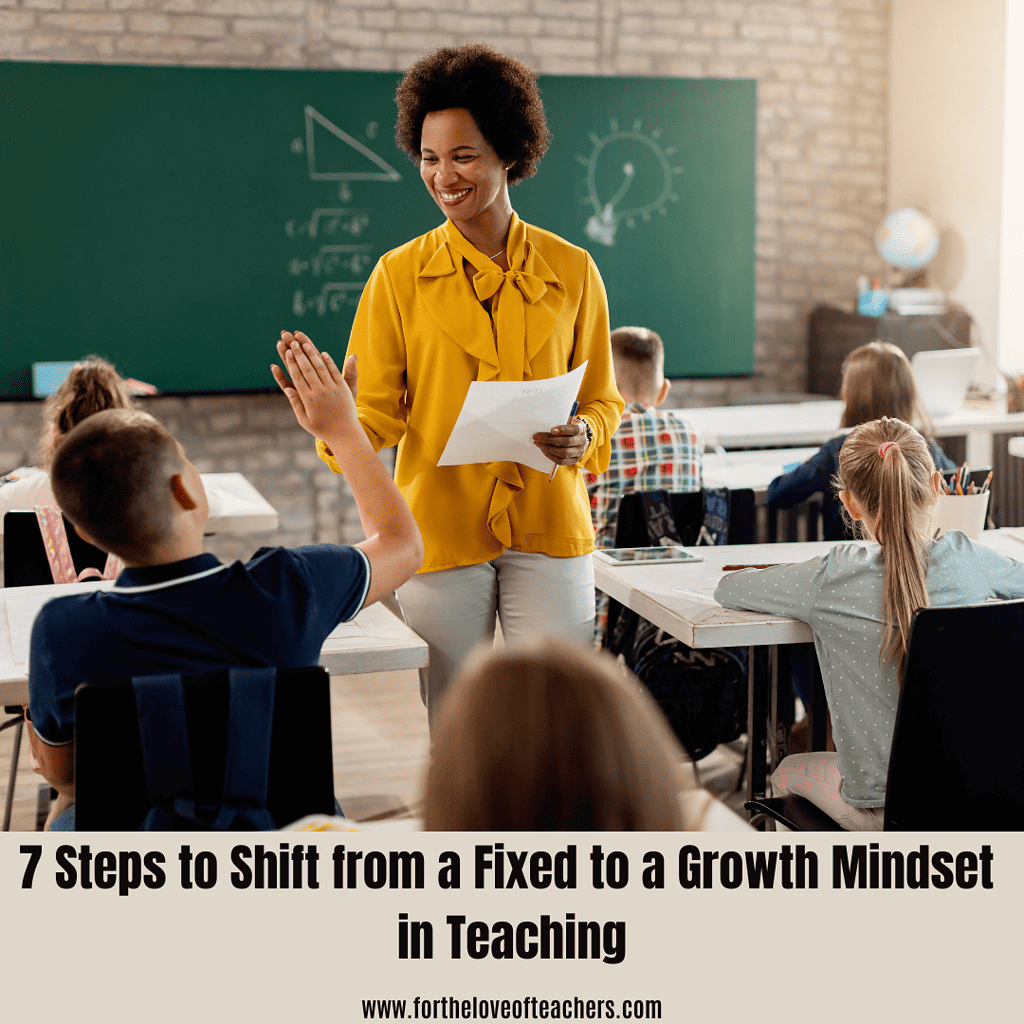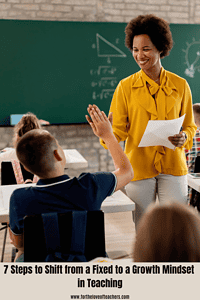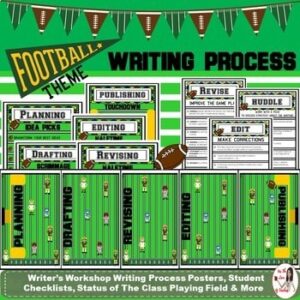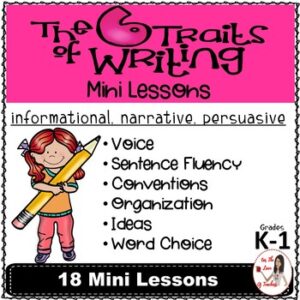Teaching goes beyond imparting knowledge to students; it’s about cultivating a mindset that enables students to embrace challenges, learn from failures, and ultimately thrive in a constantly changing world.
To help students achieve these goals, educators can transition from a fixed mindset to a growth mindset to instill resilience, adaptability, and passion for learning in the classroom. Someone with a growth mindset views abilities, talents, and intelligence as learnable skills that improve with effort. An individual with a fixed mindset sees those traits as unchangeable and inherently stable.
Modern teachers have faced numerous unheralded challenges over the last decade, and overwhelm, and burnout may cause some to autopilot through the year on a fixed mindset. However, teachers must develop the same practice if they want their students to develop a growth mindset.
Here are seven actionable steps teachers can take to nurture a growth mindset in their teaching practices and establish an environment that fosters student engagement and success.
1. Self-Reflection as a Catalyst for Change
Self-reflection is a necessary first step to transition from a fixed to a growth mindset. Teachers should assess their beliefs regarding learning, intelligence, and the capacity for growth.
Acknowledging and deeply examining any inclinations that reflect a fixed mindset that may unintentionally impact your teaching methods and attitudes is critical. By identifying and addressing these feelings and beliefs, educators can build a foundation for an approach focused on openness to growth.
2. Embracing Challenges: A Classroom Culture Shift
Be honest with students about embracing challenges, including that teachers struggle with fixed mindsets. Actively promote the idea that challenges are growth opportunities regardless of whether one succeeds or fails to overcome them. Cultivate an atmosphere in the classroom where students feel encouraged to take on challenges, understanding that it’s by overcoming difficulties that authentic learning occurs.
Teachers may include their mindset journey in the classroom by sharing when they have felt stuck in a fixed mindset and how they did or did not shift their thinking. Point out to students how hard work changes one’s perspective. Students may benefit from the chance to identify their mindset in a given situation, discuss how those mindsets feel, and explain the concepts to their instructor and peers.
3. Feedback as a Tool for Growth
Too often, students are focused on the result — a number or letter grade — rather than what they learned about effort in the process. Teachers can become caught up in that perspective as well. Feedback is a powerful way to change mindsets and prompt more reflection, evaluation, and growth for teachers and students.
Educators can provide constructive and specific feedback that focuses on learning. Highlight improvement and effort more than fixed skills. This approach allows students to view feedback as a measure of growth so they learn to value the process and effort more than the final grade.
One method that educators can use to emphasize process over result is creating a SMART (Specific, Measurable, Achievable, Relevant, and Time-Bound) goal. Promoting this growth mindset method lets students break down their work into smaller chunks while moving toward a precisely defined goal. When writing SMART goals, students can focus on clear, attainable objectives and track their progress, increasing their motivation and drive for success.
4. Language Matters: The Power of “Yet”
Language matters. Teachers can employ and model a growth mindset by shifting their use of language when conversing with students and assessing their classwork. Rather than focus on what a student has done right or wrong, address how they can develop in the future. This method puts students in a “toward state” where their brains learn to view feedback as a chance to grow and improve.
Language is essential for students who feel they “don’t belong” or are “not good enough” to do well. Positive, forward-thinking words can build a student’s confidence and increase diversity in STEM and other important fields.
Teachers can encourage their students and themselves to change their language by adding “yet” to the end of a fixed mindset statement. For example, take “I can’t do this” and change it to “I can’t do this yet.” This simple linguistic switch allows teachers and students to internalize that abilities can be developed and improved with time and effort.
5. Pressing Collaboration with Peers
Educators can create an environment for learning that promotes collaboration among students so they can gain additional knowledge from their peers. Incorporating more group tasks, peer evaluations, and collaborative projects provides chances for shared learning experiences.
Teachers reinforce the belief that learning is a collective endeavor by encouraging students to view their peers as sources of knowledge and growth. Collaboration fosters adaptability and open-mindedness, two vital aspects of a growth mindset.
6. Modeling a Growth Mindset
Ultimately, teachers serve as role models for their students. When teachers demonstrate a mindset that values growth by learning from errors and facing challenges, they set a powerful example for students. Teachers who openly address difficulties acknowledge their progress, as do teachers willing to let go of stale lesson plans and learn new methods from their colleagues. Educators who show enthusiasm for learning create a classroom environment that motivates students to do the same.
7. Lead the Way to a Growth Mindset
The transition from a fixed mindset to a growth mindset is a philosophy that can revolutionize learning for educators and students alike. When teachers embrace challenges and offer actionable feedback, they exemplify a growth mindset and inspire students to develop a passion for learning beyond the classroom’s confines.
In conclusion, embracing a growth mindset in teaching requires dedication, persistence, and a willingness to adapt. By following these seven steps, educators can cultivate an environment that fosters continuous learning, resilience, and ultimately, greater student success.
 About the Author: “Indiana Lee is a journalist with a focus on special needs, child development, and education, aiming to inform and influence positive changes in these areas through her writing. Connect with her on LinkedIn.”
About the Author: “Indiana Lee is a journalist with a focus on special needs, child development, and education, aiming to inform and influence positive changes in these areas through her writing. Connect with her on LinkedIn.”
Thanks for reading!
If you like it, then pin it!

Christine Weis is a passionate educator, classroom management coach, wife, and mom of two busy boys. She enjoys teaching, writing, and creating resources for teachers.










This is great content, but what happened to #5?
Good question–fixed!
Thank you for reading!
Christine at For The Love of Teachers
There are so many ways to keep lessons fresh and students learning. It takes a LOT of time and consistently but it’s worth it.
Some of my best memories from my earlier years are from great teachers. The good ones can make a huge impact on the lives of their students.
This is such an insightful article! I definitely agree that teaching can open up your mind so much and really foster that growth mindset we so often strive for!
Every teacher needs to read this! I feel like maybe even everyone who is around kids and want to provide a learning environment for them needs to read this.
I think the most appealing part of all of this is how it encourages more interactivity and connection between students and their teachers.
I really love this idea. Students can learn to grow and change if their teachers aren’t doing the same. This is super cool!
Teaching has always been a challenging career, but nothing compared to the atmosphere that most teachers exist in today. It would be understandable to have a fixed mindset these days when just surviving/making it through the year seems like the goal. Your ideas for motivating teachers and students alike to develop a growth-oriented mindset make a lot of sense to give both teachers and students a feeling of control and accomplishment along the way to achieving goals. Those of us who are not teachers can also benefit from developing a growth mindset to whatever challenge we are undertaking.
This is helpful content if you realize your mindset isn’t the best, and you want to switch to a growth mindset, not just for teaching, but for all goals in life!